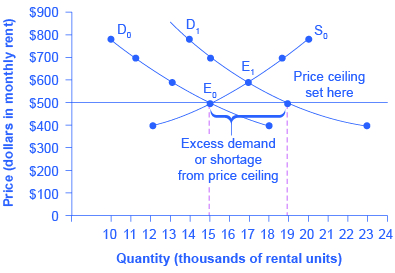Over time, big cities have undergone a lot of change involving housing and rent. For example, the documentary we watched in class, San Francisco 2.0, illustrated how wealthy people are becoming increasingly wealthier, while smaller businesses are pushed out by the big tech companies. Because of this issue regarding rent, there has been much controversy over rental control laws.
Rent control is a law passed for the purpose of regulating increases in rent, such as in renting apartments. This means that essentially, rent control is a price ceiling. A price ceiling keeps a price from rising above a certain level (hence, the ceiling).
 The controversy over rent control comes from the fact that tenants and other renters want an affordable place to live, but landlords and the housing market believe that rent control leads to dilapidated units, deferred maintenance, and an overall reduction of the rental housing stock. Therefore, whether or not price ceilings should be imposed remains questionable.
The controversy over rent control comes from the fact that tenants and other renters want an affordable place to live, but landlords and the housing market believe that rent control leads to dilapidated units, deferred maintenance, and an overall reduction of the rental housing stock. Therefore, whether or not price ceilings should be imposed remains questionable.The graph to the right illustrates a price ceiling in rental control through supply and demand curves and how changes in demand (due to changes in the popularity of an area or changes in income due to business expansion) cause a shift in the equilibrium point. A rental control would supposedly keep the equilibrium point from shifting. The horizontal line at $500 represents the fixed maximum price (the price ceiling) set by the rental control law. At this price, the quantity demanded exceeds the quantity supplied, so there is a shortage of rental housing.
Do price ceilings and rental control laws really benefit renters? It seems that the issue needs a closer look at opportunity costs and that changes in demand manipulate the effectiveness of price ceilings.
Sources:
https://opentextbc.ca/principlesofeconomics/chapter/3-4-price-ceilings-and-price-floors/
https://www.governing.com/topics/urban/gov-landlords-rent-control-stanford.html

There are certain trade-offs made when rent control is implemented. Tenants may have cheaper housing, but renters may decide to leave the market, decreasing supply and driving up costs. Historically, it seems in the short run, rent control is beneficial for tenants, but in the long run, it decreases affordability overall. San Francisco's 1990s rent control efforts contributed to the development of condominiums and new housing.
ReplyDeletehttps://www.brookings.edu/research/what-does-economic-evidence-tell-us-about-the-effects-of-rent-control/
Thank you for sharing the information about rental control. Rental control help to set market price rationally. Due to the developing technologies and more rich immigrates move in the city, rent price has been raised quickly over these years. Fortunately, California is a state that has rental control to set limits of price ceiling.
ReplyDelete